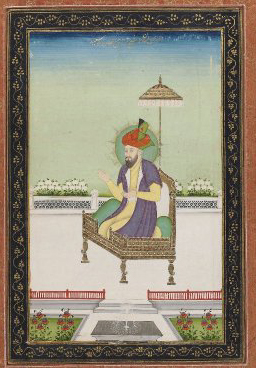Related Research Articles

Babur, born Zahīr ud-Dīn Muhammad, was the founder of the Mughal Empire in the Indian subcontinent. He was a descendant of Timur and Genghis Khan through his father and mother respectively. He was also given the posthumous name of Firdaws Makani.

Muhammad Shaybani Khan, was an Uzbek leader who consolidated various Uzbek tribes and laid the foundations for their ascendance in Transoxiana and the establishment of the Khanate of Bukhara. He was a Shaybanid or descendant of Shiban, the fifth son of Jochi, Genghis Khan's eldest son. He was the son of Shah-Budag, thus a grandson of the Uzbek conqueror Abu'l-Khayr Khan.
Ahmad Alaq ; was the Khan of Eastern Moghulistan (Uyghurstan) from 1487 to 1504. He was the second son of Yunus Khan. His mother was Shah Begum, fourth daughter of Badakhshan prince Lali.

Kamran Mirza was the second son of Babur, the founder of the Mughal Empire and the first Mughal Emperor. Kamran Mirza was born in Kabul to Babur's wife Gulrukh Begum. He was half-brother to Babur's eldest son Humayun, who would go on and inherit the Mughal throne, but he was full-brother to Babur's third son, Askari. A divan written in Persian and Chagatai is attributed to him.
Qutlugh Nigar Khanum was the first wife and chief consort of Umar Shaikh Mirza II, the ruler of Ferghana Valley. She was a princess of Moghulistan by birth and was a daughter of Yunus Khan, the Great Khan of Moghulistan.

Gulbadan Begum was a Mughal princess and the daughter of Emperor Babur, the founder of the Mughal Empire.
Sultan Said Khan ruled the Yarkent Khanate from September 1514 to July 1533. He was born in the late 15th century in Moghulistan, and he was a direct descendant of the first Moghul Khan, Tughlugh Timur, who had founded the state of Moghulistan in 1348 and ruled until 1363. The Moghuls were turkicized Mongols who had converted to Islam.
Muhammad Zaman Mirza (1496–1539) was a Timurid prince, and general to Mughal Emperors Babur and Humayun. He claimed himself as the ruler of Gujarat in 1537 but did not gain actual control.

Umar Shaikh Mirza II was the ruler of the Fergana Valley. He was the fourth son of Abu Sa'id Mirza, the emperor of the Timurid Empire in what is now Kazakhstan, Uzbekistan, Afghanistan and eastern Iran.

Abu'l-Nasir Muhammad, better known by the sobriquet Hindal, was a Mughal prince and the youngest son of Emperor Babur, the founder of the Mughal Empire and the first Mughal emperor. He was also the older brother of Gulbadan Begum, the younger half-brother of the second Mughal emperor Humayun, as well as the paternal-uncle and father-in-law of the third Mughal emperor Akbar.
Ruqaiya Sultan Begum was the first and chief wife of the third Mughal emperor, Akbar.
Aisha Sultan Begum was Queen consort of Ferghana Valley and Samarkand as the first wife of Emperor Babur, the founder of the Mughal Empire and the first Mughal emperor.

Khanzada Begum was a Timurid princess and the eldest daughter of Umar Shaikh Mirza II, the amir of Ferghana. She was also the elder sister of Babur, the founder of the Mughal Empire. She and her brother remained deeply attached to each other all their lives, a period during which the family progressed from ruling a tiny and obscure principality in Central Asia to ruling a large portion of the Indian subcontinent. Babur conferred on his sister, the honorable title of Padshah Begum and she was really the first lady of his Empire after his death.
Maham Begum or Mahim Begum was the Empress consort of the Mughal Empire from 20 April 1526 to 26 December 1530 as the third wife and chief consort of Babur, the founder of the Mughal Empire and the first Mughal emperor. She was the mother of Babur's eldest surviving son and eventual successor, Humayun.

Aisan Daulat Begum was the first wife and chief consort of Yunus Khan of Moghulistan. She was the mother of Qutlugh Nigar Khanum, and hence the grandmother of the first Mughal emperor, Babur. During the reign of her grandson, she functioned as his de facto regent and advisor, from 1494 to 1505.
Shah Begum was the Queen consort of Moghulistan as the second wife of Yunus Khan, a descendant of Chaghatai Khan, the second son of Genghis Khan. She was the mother of Mahmud Khan and Ahmad Alaq, the next Moghul Khans of Moghulistan.
Masuma Sultan Begum was the Queen consort of Ferghana Valley and Samarkand as the fourth wife of Emperor Babur, the founder of the Mughal Empire and the first Mughal emperor.
Mihr Nigar Khanum was the first wife of Sultan Ahmed Mirza, the King of Samarkand and Bukhara. She was a princess of Moghulistan by birth and was the eldest daughter of Yunus Khan, the Great Khan of Moghulistan and his chief consort Aisan Daulat Begum. She was also the aunt of Emperor Babur, the founder of the Mughal Empire of India as well as its first Emperor.
Masuma Sultan Begum was a Mughal princess and the daughter of the first Mughal emperor, Babur. She is frequently mentioned in the Humayun-nama by her sister, Gulbadan Begum, who calls her sister 'Elder sister Moon'.
Shakr-un-Nissa Begum, also Shakr al-Nisa Begum was a Mughal princess, the daughter of Emperor Akbar.
References
- ↑ Bābur (Mogulreich, Kaiser), John Leyden, William Erskine (1826). Memoirs of Zehir-ed-Din Muhammed Baber, Emperor of Hindustan. Longman.
{{cite book}}: CS1 maint: multiple names: authors list (link) - ↑ Babur (Emperor of Hindustan) (2006). Babur Nama: Journal of Emperor Babur. Penguin Books India. ISBN 978-0-144-00149-1.
- ↑ Begum, Gulbadan (1902). The History of Humayun (Humayun-Nama). Royal Asiatic Society. ISBN 8187570997.